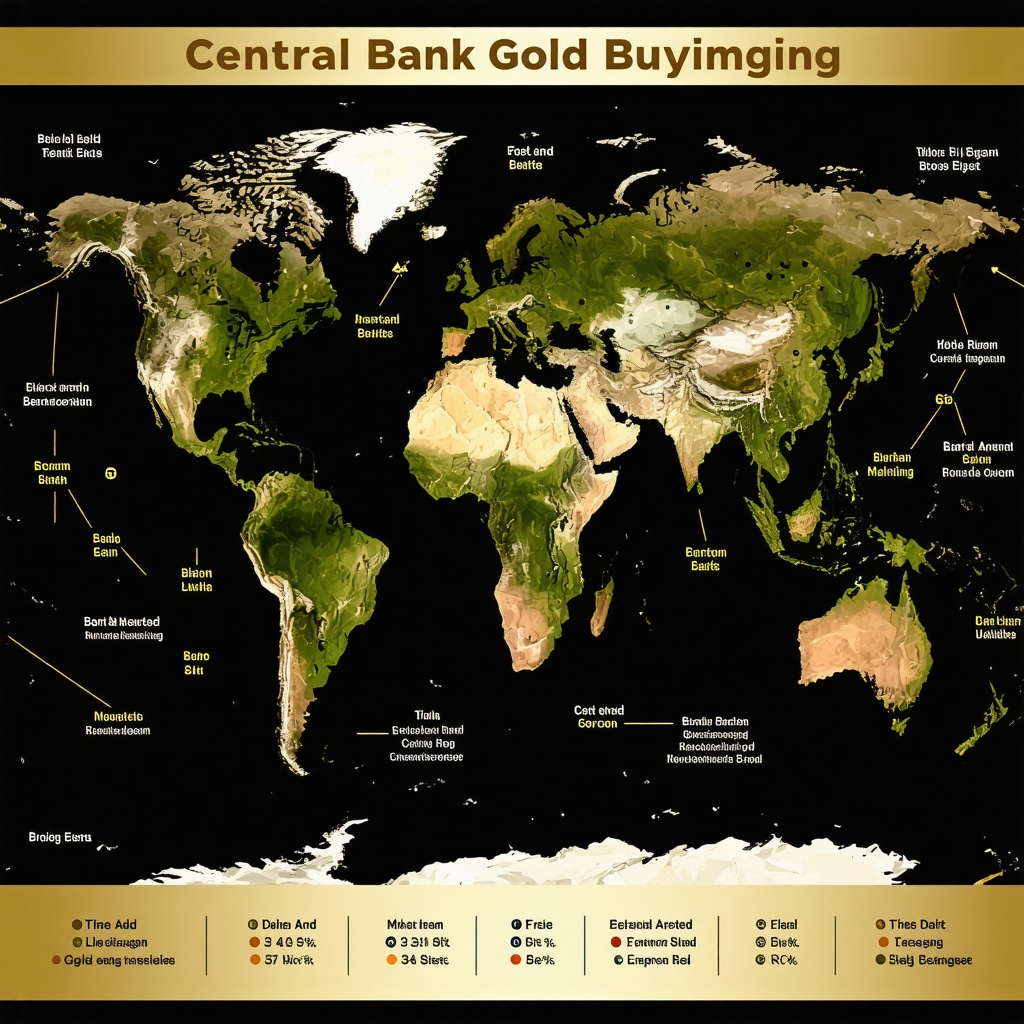When Central Banks Whisper, Gold Listens
Imagine a grand ballroom where the world’s financial heavyweights gather. The central banks are the seasoned dancers, their moves subtle yet commanding, orchestrating the rhythm of the global gold market. When these institutions start buying gold, it’s not just a mere transaction; it’s a statement that ripples across continents, influencing demand trends with the finesse of a maestro.
Why Does Central Bank Gold Buying Matter So Much?
Central banks hold the keys to national economic stability, and gold is often their trusty sidekick. Unlike the average investor, their buying patterns are driven by strategic motives—hedging against currency risks, diversifying reserves, or signaling economic confidence. When a central bank announces increased gold purchases, it often sparks a domino effect, encouraging other market players to follow suit, thereby amplifying global demand.
Could Central Banks Be the Market’s Invisible Hand?
Here’s a thought to chew on: are central banks the puppet masters behind gold’s price swings? While supply and demand dynamics play their usual roles, the hefty gold acquisitions by central banks can tip scales unexpectedly. Their buying can tighten supply, nudging prices upward, or inject confidence that lures investors. For instance, the World Gold Council reports that in recent years, central banks have been net buyers of gold, signaling a shift in global financial strategies (source: World Gold Council).
Reading the Gold Tea Leaves: What Investors Should Watch
For savvy investors, keeping an eye on central bank gold activities is like having an inside scoop. It’s not just about the volume bought but the reasons behind these purchases. Are they reacting to geopolitical tensions, inflation fears, or a desire to reduce reliance on the US dollar? Understanding these motives can provide clues about future demand trends and price movements.
If you’re curious about how these dynamics could shape your investment strategy, you might want to delve deeper into how central bank gold purchases impact market prices and their influence on global demand trends in 2025.
Looking Beyond The Bullion: The Bigger Picture
Central banks don’t just buy gold for the sparkle; their moves often reflect broader economic narratives. Their purchasing decisions can signal shifts in monetary policy or reactions to international crises. This interplay adds layers of complexity and intrigue to the gold market, making it a fascinating arena for investors and economists alike.
Have you noticed how these silent market maestros influence your investment decisions? Share your thoughts or experiences on central bank gold buying and its ripple effects below. Let’s turn this column into a lively conversation about the golden threads weaving through global finance.
Central Banks’ Strategic Gold Moves: What Lies Beneath?
Central banks’ gold purchases are often wrapped in layers of strategy beyond mere accumulation. Their motives can include managing currency volatility, safeguarding against geopolitical risks, or even preparing for shifts in global economic governance. These nuanced drivers mean investors must look past headline numbers to understand the underlying economic narratives. For example, a surge in gold buying amidst rising geopolitical tensions often indicates a precautionary stance, suggesting that central banks foresee potential instability ahead.
How Do Central Banks’ Gold Policies Shape Global Investment Strategies?
This question cuts to the heart of the intersection between institutional actions and market psychology. Central banks, through their gold reserve management, indirectly influence investor sentiment worldwide. When they increase gold holdings, it often signals a lack of confidence in fiat currencies or traditional assets, prompting investors to reassess their portfolio allocations. This ripple effect can lead to increased demand for gold ETFs, bullion, and mining stocks, as market participants seek similar safe-haven qualities.
Moreover, the timing and scale of these purchases can affect gold price volatility. Sudden large acquisitions may tighten physical supply, causing price spikes, while consistent buying over time tends to support a stable upward trend. Investors can benefit from monitoring official central bank reports and announcements, which serve as valuable indicators of potential market shifts.
For those interested in exploring how to align their portfolios with these institutional signals, resources like strategic gold investment techniques provide expert insights on leveraging gold’s unique market dynamics.
Central Bank Gold Reserves: A Mirror to Geopolitical Realities
Gold reserves held by central banks often reflect broader geopolitical strategies. For example, countries facing sanctions or economic isolation may increase gold purchases to bypass traditional financial systems and preserve wealth. Similarly, nations involved in regional conflicts or diplomatic tensions might bolster reserves as a hedge against currency devaluation or economic disruption.
These geopolitical undercurrents add a complex dimension to gold demand, intertwining economic policy with international relations. Investors who appreciate this complexity can better anticipate demand surges linked to geopolitical events, rather than relying solely on technical market analysis.
According to an analysis by the International Monetary Fund (IMF), central bank gold reserves have become increasingly significant in shaping global financial stability, especially in times of crisis (source: IMF Working Paper).
Investing in Gold: Beyond the Numbers and Into the Narrative
Understanding central bank gold buying is not just about tracking figures; it’s about interpreting the stories those figures tell. Each purchase is a chapter in a larger narrative of economic confidence, risk management, and strategic positioning. For investors, this means that gold is more than a commodity—it’s a barometer of global financial health.
Engage with this dynamic by sharing your perspectives or experiences regarding central bank influences on gold markets. How have these institutional moves shaped your investment decisions? Join the conversation below and connect with a community of informed investors.
Unveiling the Subtle Signals: How Central Bank Gold Purchases Forecast Economic Turbulence
Central banks don’t just buy gold on a whim; their acquisition patterns often precede seismic shifts in economic landscapes. By analyzing the timing, frequency, and scale of these purchases, investors can glean advanced foresight into impending inflationary pressures or currency realignments. For example, a sustained increase in gold reserves during periods of low market volatility might indicate an anticipatory move against latent financial risks. This sophisticated reading of central bank behavior demands not only data scrutiny but also an understanding of the geopolitical undercurrents that drive such decisions.
What Are the Leading Indicators Within Central Bank Gold Transactions That Signal Global Economic Stress?
Deep-diving into central bank gold transactions reveals nuanced indicators beyond headline purchase volumes. Patterns such as sudden accelerations in buying amidst geopolitical crises—like trade wars or regional conflicts—can signal increased risk aversion. Moreover, shifts in the geographic distribution of gold reserves, such as emerging markets augmenting their holdings, often reflect broader strategic recalibrations. These leading indicators can serve as early warnings for portfolio managers aiming to hedge against volatility.
According to detailed reports by the World Gold Council, central banks in Asia and the Middle East have notably ramped up gold purchases in recent years, correlating with regional economic diversification and geopolitical uncertainties.
Integrating Central Bank Signals Into Sophisticated Investment Portfolios
For institutional and high-net-worth investors, integrating central bank gold buying patterns into portfolio strategies can enhance risk-adjusted returns. This requires moving beyond simplistic gold exposure to dynamic allocation models that respond to real-time signals from central bank behaviors. For instance, during periods of escalated gold buying by central banks, increasing allocations to physical gold, gold mining equities, or ETFs can capitalize on anticipated price appreciations. Conversely, understanding when central banks reduce gold holdings can inform tactical de-risking.
Advanced portfolio frameworks also consider the interplay between gold and other asset classes influenced by central bank policies, such as sovereign bonds and currencies. This holistic approach enables investors to finely tune exposure to macroeconomic shifts.
Gold’s Role in De-Dollarization: Central Banks Leading a Quiet Revolution?
One of the most compelling narratives behind central bank gold buying is its role in the gradual de-dollarization of global reserves. As some countries seek to reduce dependence on the US dollar amidst geopolitical tensions and sanctions, gold emerges as a neutral, universally accepted asset. This shift is not merely transactional but strategic, embedding gold into the fabric of international monetary realignments.
Experts argue that this trend could reshape the gold market’s supply-demand dynamics fundamentally, with central banks acquiring increasing shares of available bullion, tightening liquidity for private investors. This phenomenon necessitates investors to anticipate and adapt to a market where central bank demand becomes a dominant force.
For more on this intricate subject, the IMF Working Paper provides an authoritative exploration of gold’s evolving role in global reserves amidst geopolitical shifts.
From Theory to Practice: How Can Investors Leverage Central Bank Gold Buying Insights?
Understanding the complex motives and patterns of central bank gold acquisitions empowers investors to make informed, strategic decisions. This involves continuous monitoring of official reserve reports, geopolitical developments, and macroeconomic indicators. By synthesizing these data points, investors can anticipate demand surges or contractions and adjust their gold exposure accordingly.
Engaging with expert analyses, such as those found in strategic gold investment techniques, provides practical frameworks to harness these insights effectively.
Are you ready to refine your investment approach by integrating the subtle yet powerful signals from central bank gold buying? Dive deeper into this fascinating intersection of economics and geopolitics and transform how you perceive gold’s role in your portfolio.
Decoding Central Bank Gold Buying: Advanced Insights and Strategic Investment Implications
Central bank gold acquisitions are a powerful yet often opaque force influencing global markets. Beyond mere accumulation, these purchases weave a complex tapestry of economic signaling and strategic intent that savvy investors must decode to stay ahead. As central banks adjust their gold reserves in response to shifting geopolitical tensions and evolving monetary policies, they impart subtle signals that can herald broader market transformations.
How Can Investors Interpret Central Bank Gold Movements to Anticipate Market Volatility?
Understanding the nuanced patterns of central bank gold buying involves more than tracking headline purchase volumes. Investors should analyze the timing, scale, and frequency of transactions in conjunction with geopolitical events and macroeconomic indicators. For instance, a surge in gold reserves during periods of relative market calm may presage latent inflationary pressures or currency realignments. Conversely, sudden buying spikes amidst geopolitical crises often reflect heightened risk aversion and a flight to safe-haven assets.
Recent research from the World Gold Council highlights that central banks in Asia and the Middle East have significantly increased their gold reserves, correlating with strategic diversification efforts and regional geopolitical uncertainties (source: World Gold Council). This trend underscores the importance of monitoring geographical shifts in central bank behavior to anticipate emerging market risks and opportunities.
For investors seeking to harness these insights, integrating central bank signals into dynamic portfolio strategies can enhance risk-adjusted returns. Approaches may include tactical increases in physical gold holdings, selective exposure to gold mining equities, or optimized allocations within gold ETFs. Resources like strategic gold investment techniques offer valuable guidance for aligning investments with these institutional cues.
Central Banks and the De-Dollarization Phenomenon: What It Means for Gold Investors
The gradual de-dollarization of global reserves is a compelling narrative driving central bank gold purchases. As nations navigate the challenges of geopolitical tensions and economic sanctions, gold serves as a neutral, universally accepted asset, providing a reliable store of value independent of US dollar dominance. This paradigm shift not only alters the composition of global reserve assets but also reshapes gold market supply-demand dynamics.
Central banks acquiring larger shares of bullion effectively tighten physical supply availability for private investors, potentially driving price appreciation and volatility. This evolving landscape necessitates that investors adapt their strategies in anticipation of sustained institutional demand. For a comprehensive examination of gold’s role amid these geopolitical realignments, the IMF Working Paper provides an authoritative resource.
Advanced Portfolio Integration: Leveraging Central Bank Gold Signals for Optimal Asset Allocation
Institutional and sophisticated investors can significantly benefit from incorporating central bank gold buying patterns into their portfolio frameworks. This entails moving beyond static gold exposure toward dynamic allocation models that respond to real-time central bank behaviors. For example, periods of intensified gold accumulation by central banks may warrant increased allocation to physical gold, gold ETFs, or mining stocks to capitalize on upward price momentum.
Conversely, signs of reduced central bank gold purchasing activity can inform tactical portfolio de-risking, mitigating exposure before potential price corrections. Moreover, integrating gold with other assets influenced by central bank policies—such as sovereign bonds and currencies—enables a holistic macroeconomic approach that finely tunes risk and return profiles.
For practical steps on constructing a balanced portfolio that leverages these insights, consider exploring how to choose the best gold ETFs for a balanced portfolio to complement your physical gold holdings.
Engage with the Community: Share Your Perspectives on Central Bank Gold Influence
The interplay between central bank gold buying and market dynamics is as intricate as it is impactful. How have these silent institutional moves influenced your investment decisions? Have you adjusted your portfolio in response to recent central bank gold trends? We invite you to share your experiences and insights in the comments below to foster a rich discussion among informed investors.
For those eager to deepen their understanding of gold investing amid these complex dynamics, our expert-curated strategies provide a robust starting point.

Expert Insights & Advanced Considerations
Central Bank Gold Buying as a Leading Economic Indicator
Central banks’ gold purchases often precede shifts in global economic stability, acting as a subtle yet powerful leading indicator. Analyzing the timing and scale of these acquisitions alongside geopolitical and macroeconomic contexts can offer investors an advanced predictive edge on inflationary trends and currency realignments.
De-Dollarization Drives Sustained Institutional Demand
The ongoing de-dollarization trend among several central banks intensifies gold’s role as a neutral reserve asset. This strategic pivot not only tightens bullion supply for private investors but also signals a fundamental reshaping of global reserve compositions, compelling investors to reconsider traditional asset allocations.
Dynamic Portfolio Allocation Informed by Central Bank Activity
Incorporating central bank gold buying patterns into portfolio strategies enables more nuanced risk management. By dynamically adjusting exposure to physical gold, ETFs, or mining equities in response to institutional buying or selling, investors can better navigate market volatility and optimize returns.
Geopolitical Risk Reflected in Gold Reserve Shifts
Central banks’ gold reserves frequently mirror geopolitical tensions and economic sanctions. Recognizing these patterns helps investors anticipate demand surges correlated with regional conflicts or diplomatic strains, enriching investment analysis beyond typical market data.
Interpreting Subtle Signals Requires Deep Market Literacy
Understanding the nuanced motives behind central bank gold acquisitions demands more than surface-level data tracking. Investors benefit from synthesizing official reports, geopolitical developments, and economic indicators to decode the strategic intent and forecast market impact accurately.
Curated Expert Resources
World Gold Council Central Bank Gold Reserves Report: Offers comprehensive data and analysis on global central bank gold activities, invaluable for tracking institutional trends and understanding strategic shifts. Explore the report.
International Monetary Fund (IMF) Working Paper: The Role of Gold in Central Bank Reserves: Provides authoritative insights into gold’s evolving role amid geopolitical and economic realignments, essential for grasping its macroeconomic significance. Read the paper.
BuyingGoldNow Strategic Gold Investment Techniques: Practical guidance on leveraging central bank signals within investment strategies to grow wealth and manage risk effectively. Discover expert strategies.
BuyingGoldNow Central Bank Gold Buying Influence: In-depth exploration of how central bank purchases shape global demand trends and market dynamics, critical for advanced investor awareness. Learn more.
BuyingGoldNow How to Choose the Best Gold ETFs for a Balanced Portfolio: Helps investors integrate gold ETFs into diversified portfolios aligned with central bank demand signals. Explore ETF selection.
Final Expert Perspective
Central bank gold buying remains a complex yet indispensable lens through which to understand global financial currents. Far beyond mere accumulation, these institutional moves encode strategic signals about economic confidence, geopolitical risk, and monetary policy trajectories. For investors attuned to these subtle narratives, gold transcends its role as a commodity, becoming a vital barometer and hedge within sophisticated portfolios. Embracing this deeper understanding allows for more informed, agile investment decisions that anticipate market shifts rather than merely react to them.
As you refine your approach to gold investing, consider how central bank activity can inform your strategy and risk management. Engage with the broader community of informed investors, share your insights, and explore expert resources to deepen your mastery of this dynamic market. For foundational guidance on integrating gold effectively, start with how to choose the best gold ETFs for a balanced portfolio and further expand your knowledge from there.











The analogy of central banks as seasoned dancers in a grand ballroom really resonates with me. Their gold-buying moves are indeed subtle but have profound impacts, much like a well-choreographed performance that sets the tone for the entire market. I’ve often wondered how much of gold’s price volatility can be directly attributed to these institutional moves versus typical supply-demand shifts. The domino effect mentioned—where one central bank’s acquisition prompts others to follow suit—seems to amplify demand and can sometimes catch individual investors off guard who aren’t watching these signals closely.
In my experience, understanding the geopolitical backdrop behind central bank purchases offers deeper insight than just tracking volumes. For instance, seeing a surge in gold buying from emerging market central banks often aligns with their efforts to shield themselves against currency devaluation or global economic uncertainties. This layered context helps explain not just price movements but also the strategic intent shaping those moves.
I’m curious to hear from others: how do you factor in central bank gold activity when deciding your own gold investment strategies? Do you rely mostly on economic indicators, geopolitical news, or direct reserve reports to anticipate these institutional moves? It feels like mastering this interplay could be a key advantage in navigating gold markets effectively.
This article really highlights how central banks act as the secret puppeteers influencing gold prices behind the scenes. From my perspective, tracking their reserve changes is invaluable, especially as we see shifts towards diversification away from the US dollar. I recall reading about some Asian central banks ramping up their gold reserves, which seemed to align with broader geopolitical moves and economic stabilization strategies.
What I find intriguing is the potential for these actions to foreshadow larger economic shifts. For instance, a sustained increase in gold buying could indicate hedging against inflation or currency devaluation risks brewing beneath the surface.
In your experience, how early do you think retail investors should start paying attention to official reserve reports? Do you see them as leading indicators, or are they more of confirming signals after the fact? Understanding this can greatly refine investment timing in such a nuanced market.